This post may contain affiliate links. Please see our disclosure policy.
Dandelion honey is a simple syrup made from dandelion petals, sugar, and water. Dandelion petals taste like honey, creating a lovely wild foraged honey-flavored syrup that you can easily make at home.
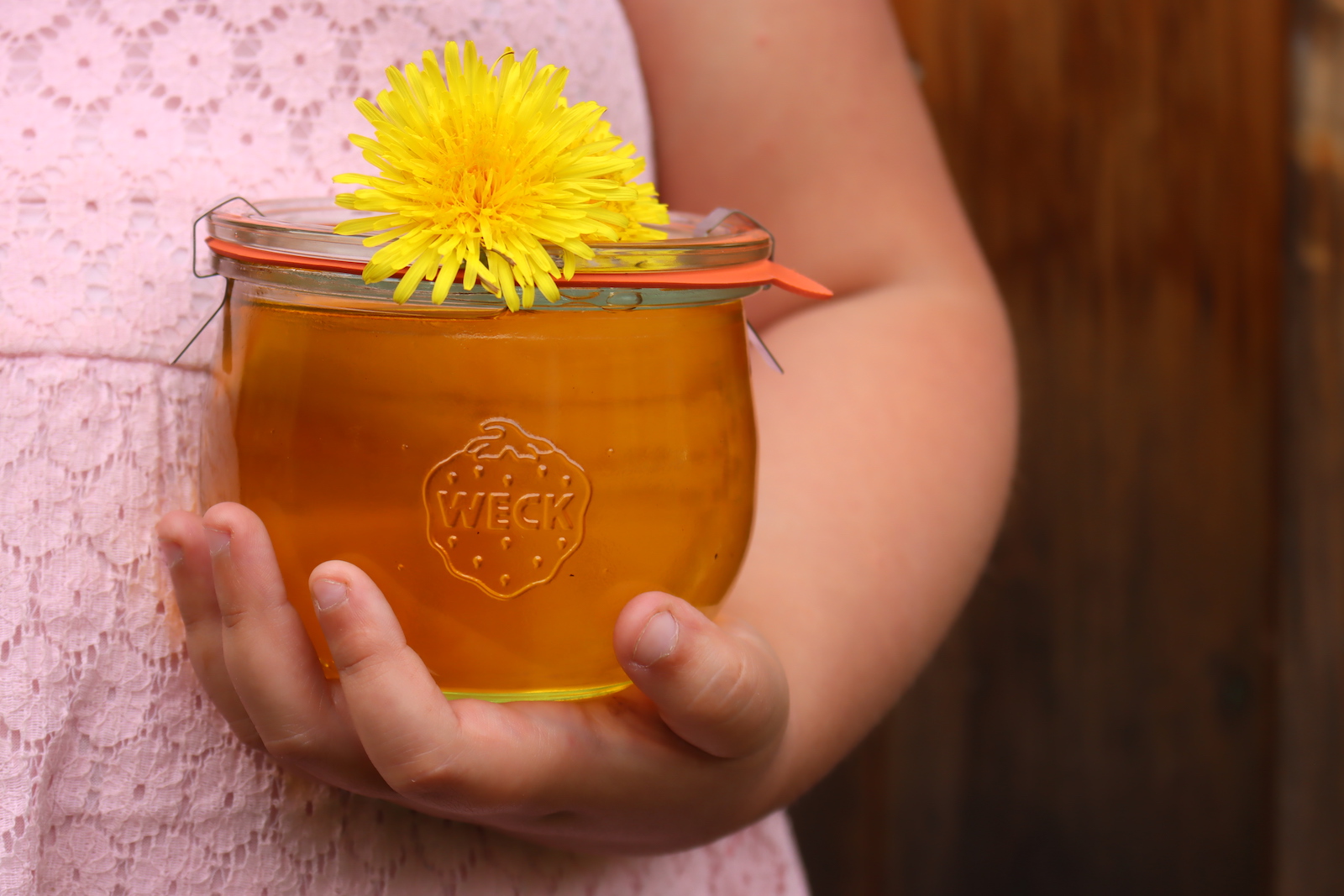
Dandelions carpet our 30 acres here in Vermont, bursting into a bright carpet each spring. I like to joke that we’re basically dandelion farmers, and we could harvest these beauties by the tractor-trailer load, and the bees would never notice.
So every spring, make a few new dandelion recipes, from old-fashioned dandelion wine to more modern treats for the kids, like dandelion cookies and dandelion marshmallows.
When we want sweet honey-flavored treats, I make dandelion flower recipes. For savory recipes like sauteed greens, salads, pesto, and pasta, I reach for dandelion greens recipes. And for the best medicine, I put in the extra work and dig roots for dandelion root recipes.
Obviously, my littles are fond of those sweet dandelion petals. They’ll gladly skip around the yard with their foraging baskets if they know these dandelions are destined for new dandelion dessert recipes. The base of many of those recipes is “Dandelion Honey,” a simple syrup made from dandelion petals, sugar, and water.
Dandelions taste like honey, you see…or perhaps it’s better to say that honey tastes like dandelions, depending on how you look at it. The nectar of those first dandelions makes the first honey, after all.
These days, dandelion honey is mostly used as a vegan honey substitute, but it has a long, rich history that goes back to the middle ages.
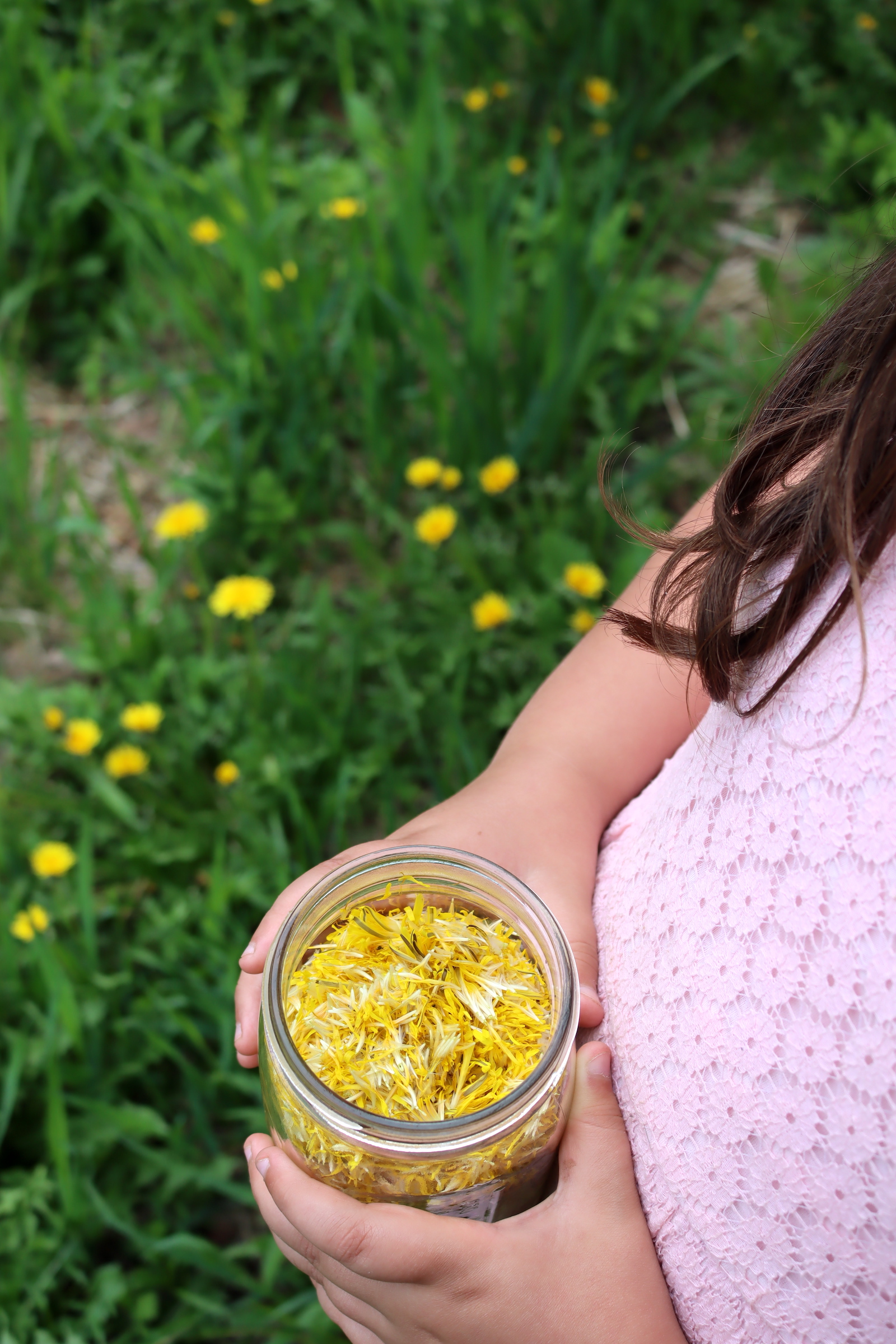
History of Dandelion Honey
Dandelion “honey” is an old-fashioned recipe from Scandinavia, where believe it or not, honey has always been expensive. That area of the world has a reputation as the home of Vikings and mead (honey wine), but real honey mead was something only really available to the highest ranks in society.
(All the peasants lived on crisp rye bread, fermented fish, and watery rye beer…maybe a little smoked sheep’s head for special occasions. Don’t get me wrong, I love Scandinavian food in all its forms, but it wasn’t all mead hall feasts as the movies would have you believe.)
When international shipping and trade began, Scandinavians celebrated the holidays with rich cookies filled with cream, butter, and expensive foreign spices. Almost every Norwegian Christmas cookie has a healthy dose of cardamom, plus cinnamon and ginger for good measure.
Imported sugar became common, along with imported spices…but real honey was still hard to come by.
Honey bees don’t thrive in that harsh northern climate, and mead was still a status symbol, even in the middle ages.
While real honey was hard to come by, you could make dandelion honey from all the wild dandelions that filled every field and pasture each spring.
It’s made with sugar, which doesn’t ferment the same way as honey, and won’t make a good mead…but it does work just fine everywhere else you’d use honey. Dandelion honey is perfect for sweetening tea or sweetening baked goods, and it’s just as good as honey in most ways (except for making alcohol).
So, why not save the real honey for mead, and make DIY dandelion honey for everything else?
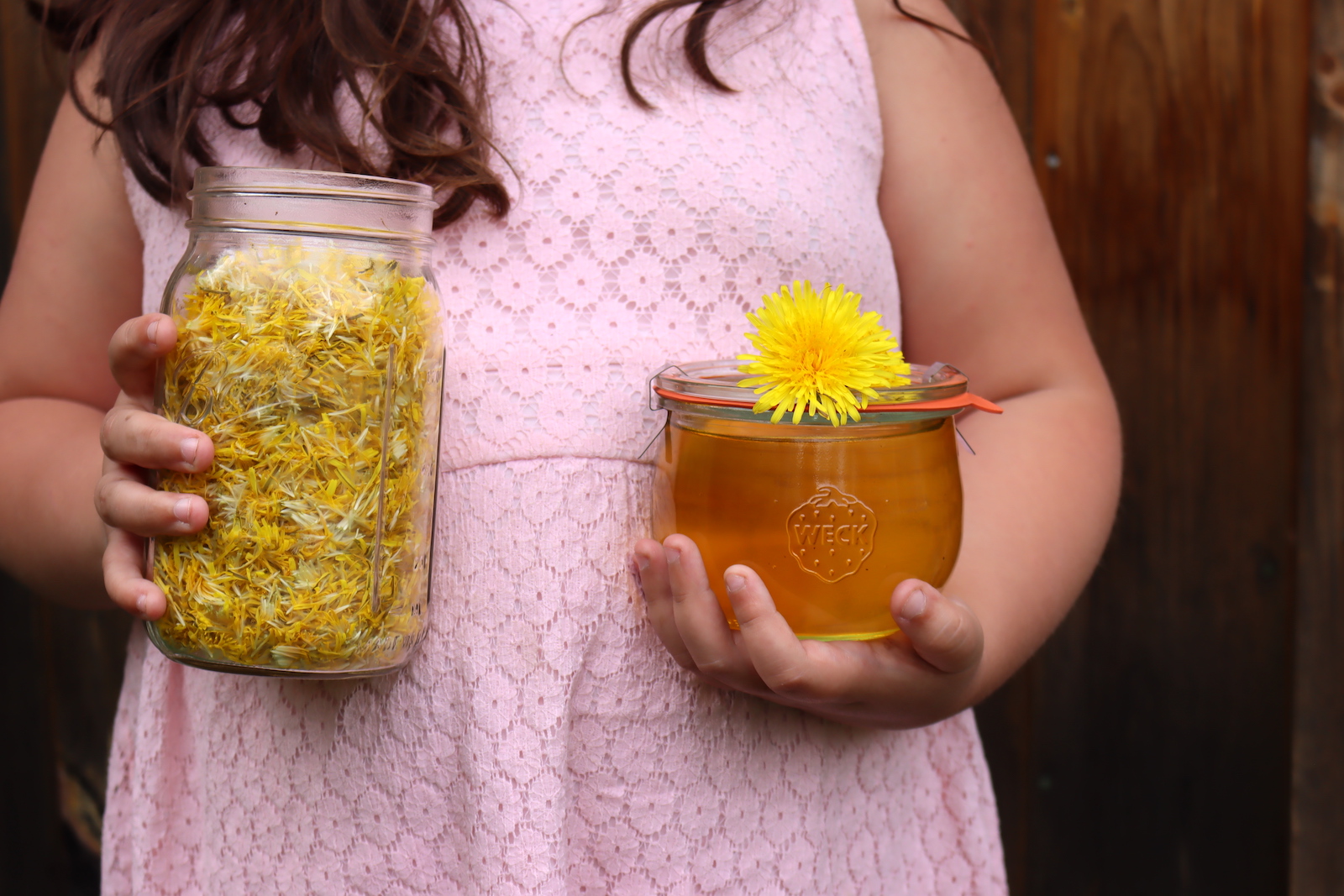
Ingredients for Dandelion Honey
There are two main ways to make dandelion honey.
One is very simple, and just uses dandelion petals, sugar, water, and a splash of lemon juice to create a honey-flavored syrup. It thickens naturally as the sugar concentrates, and you just cook it until it’s formed a rich, honey-like syrup before straining out the dandelion petals.
The main benefit here is that the flavor is really pure, and the honey-like taste of the dandelion petals can really come through without any distractions. That’s how dandelion honey is usually made these days.
The downside to this method is that it takes a lot more sugar, since you’re thickening the “honey” by concentrating the sugars. It gives you something that sweetens like honey, which is great in the modern day, but not ideal if you’re in the middle ages and sugar is costly.
Historically, dandelion honey was made more like a loose set jelly. Green apples were added as a source of pectin to help it thicken. (These days, we still make dandelion jelly, but it’s made with boxed pectin for a firmer set and brighter flavor.)
There are tart, hard, pectin-rich storage apples that would be stored all winter and still be hard come spring. We have one such tree, a Newton Pippin apple, and they don’t soften or sweeten until they’ve been stored for 9 to 12 months, believe it or not. Crazy the variety of apples that used to grow in the old world, for every purpose under the sun…even thickening early spring preserves.
I will take you through both methods of making dandelion honey, but I’d suggest using the simple modern method for the best flavor.
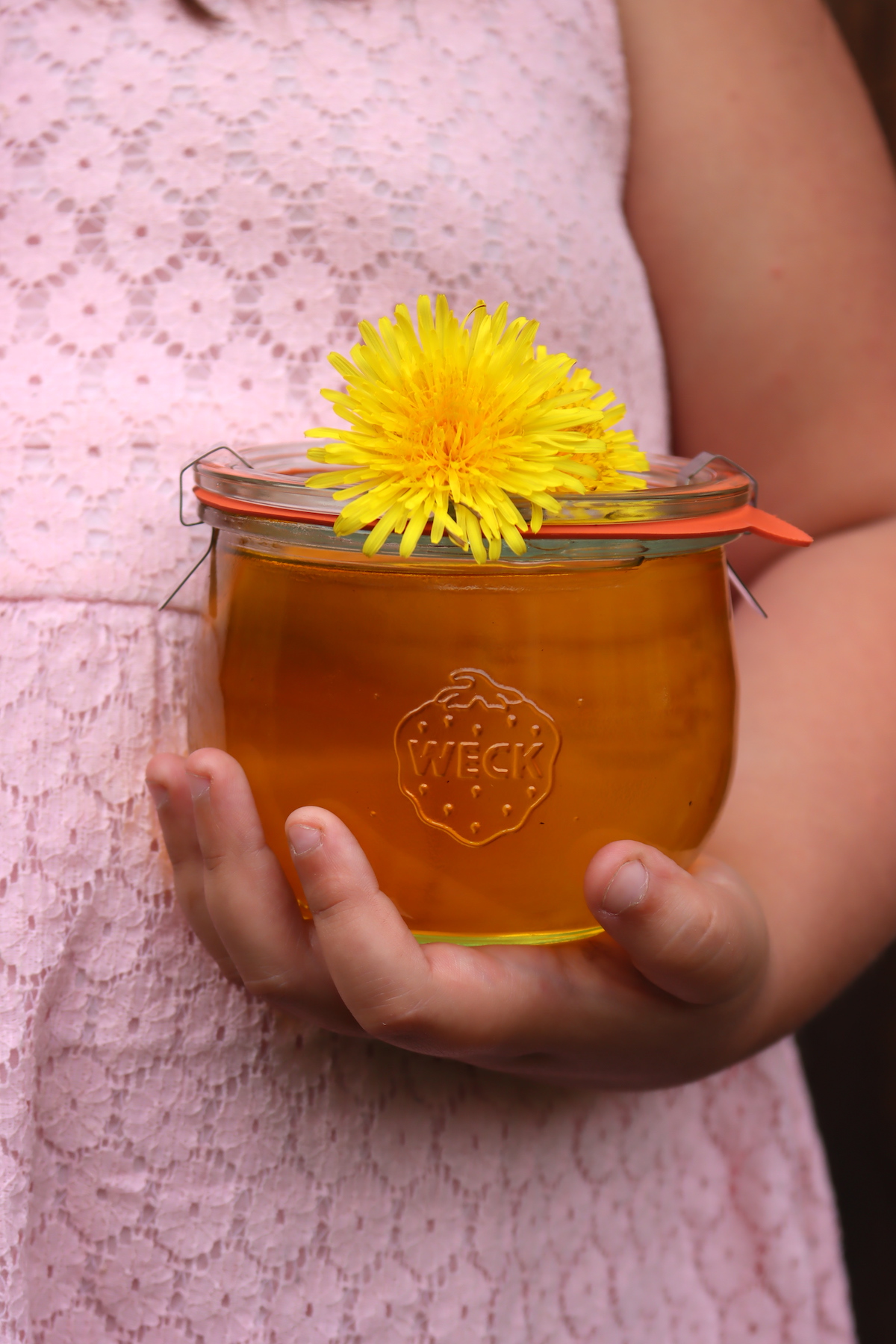
How to Make Dandelion Honey
Making dandelion honey is pretty simple, really. All you need to do is harvest dandelion blossoms, clean the petals from the green parts, and then simmer them with water and sugar until it thickens.
While it’s simple, there is one time-consuming part…namely, cleaning the dandelion petals.
The green parts of dandelions are all bitter, and the sepals that surround the honey-sweet dandelion petals are especially bitter, even more than the regular leaves and greens. If you include the green sepals, your dandelion honey will be bitter, which more or less ruins it.
Start by collecting dandelion blossoms on a sunny day, in mid to late morning, when they’re fully open and at their prime.
The blossoms take up about four times as much space as the cleaned blossoms, so if you want one cup of dandelion petals, you’ll need four cups of blossoms.
Next, carefully break each dandelion in half, separating it into two sides (left and right). You now have the center open to you, and you can use your fingers to pull the petals out of the center without getting any of the greens around the outside.
My kids can harvest a gallon of dandelion blossoms in about 5 to 10 minutes, and then this Mama sits in the shade separating petals while they play. With practice, you can clean about a quart of petals in an hour.
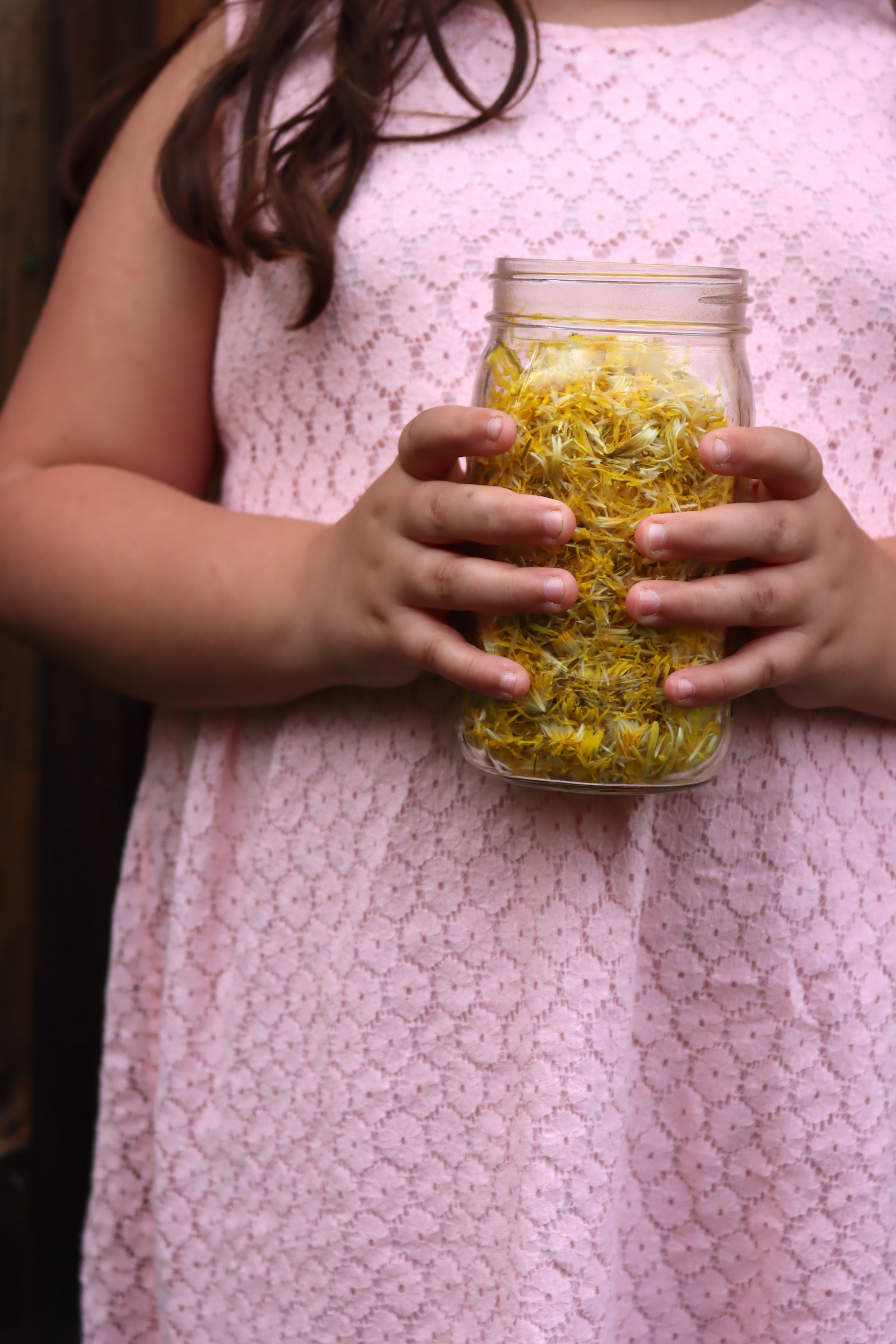
Once you’ve cleaned the dandelion petals, the next step is making dandelion petal tea.
There are a couple of different ways you can go about this, and answers all around the internet vary widely. Some say you need to infuse it overnight, and some say that 15 minutes is enough. Some say to simmer the petals in water, and others say just pour boiling water over the petals.
We’ve been working with dandelion tea for years here…and I can tell you that it honestly doesn’t matter all that much. Cooking the petals will drive off some of their more nuanced floral flavor, but even simmering for half an hour will still give you a lovely dandelion honey.
Simply pouring boiling water over the dandelion petals and waiting 15 to 20 minutes will also give you excellent dandelion honey. It’s all good.
Most recipes also tell you that you need whole sliced lemons for the recipe, largely because lemon peels are very high in pectin, so that helps thicken the honey. These same recipes have you simmer the lemon slices, peel, and all, along with the dandelion petals, for about 30 minutes. That process drives off some of the dandelion petal flavor, and extracts bitter flavors from the lemon peels at the same time.
While lemon peels are high in pectin, they also have a good bit of bitterness, especially when you cook them. You can taste that same bitterness when you make lemon marmalade, and it impacts the quality of the finished dandelion honey.
I suggest adding just plain lemon juice, which also has plenty of pectin, but lacks the bitterness of the white pith and peel.
(Honey is naturally a tiny bit acidic, so you do need a bit of acid added here to match the flavor of honey in the finished syrup. You also need it for preservation, as the dandelion honey needs to be a bit acidic to keep.)
The total amounts in this recipe depend on how many dandelion petals you have the patience to clean.
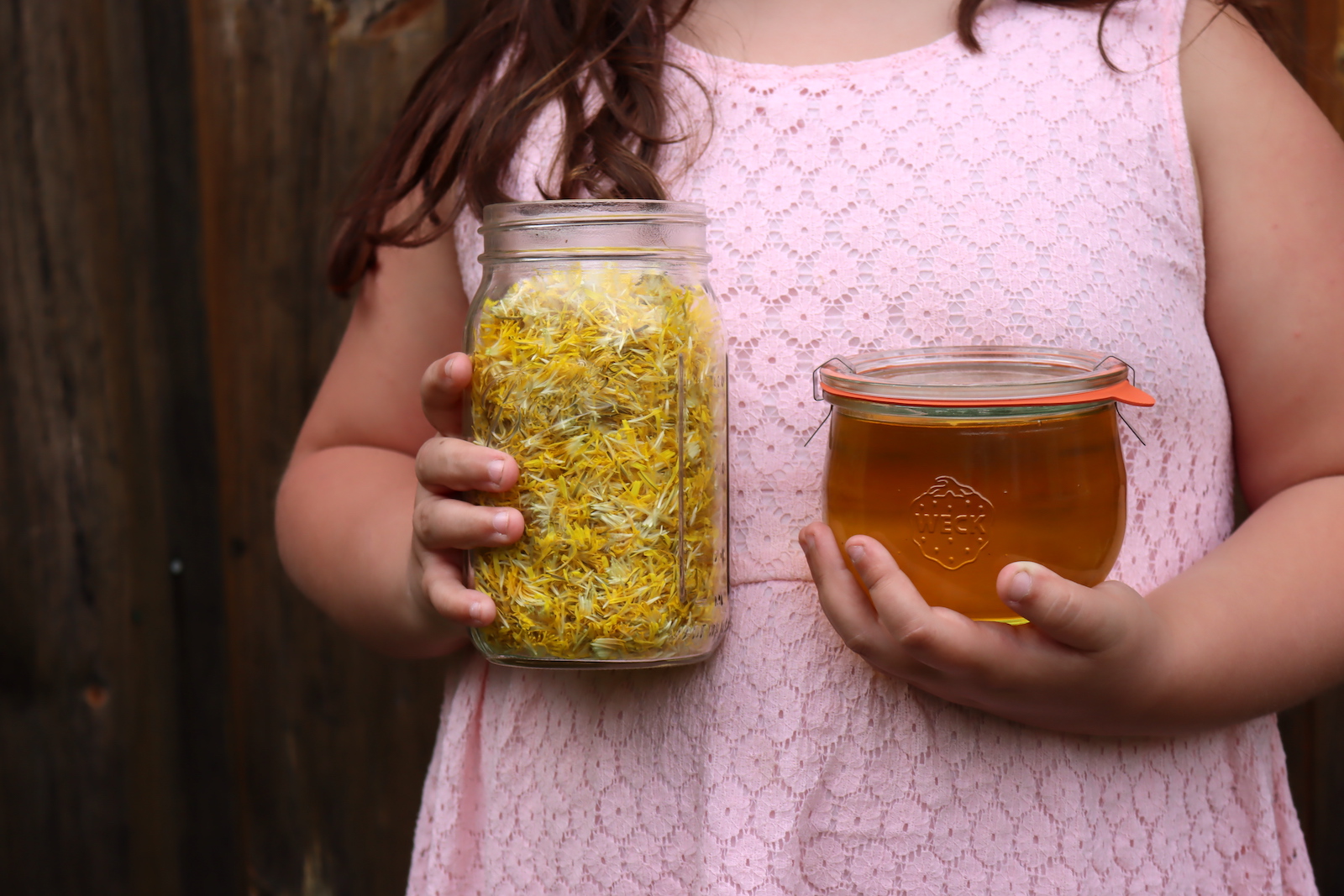
You’ll add 2 cups water and 1 cup white sugar for every cup of cleaned petals, measured fluffy, not packed. You also need 1/2 Tablespoon of lemon juice (or 1/8 tsp. citric acid). The ratio is as follows:
- 2 cups water
- 1 cup dandelion petals, yellow parts only, fluffy, not packed
- 1 cup sugar
- 1/2 Tbsp. lemon juice (or 1/8 tsp. citric acid)
Add two cups of water to a saucepan and bring the water to a boil on the stove. Once boiling, remove it from the heat. Add the cleaned dandelion petals, and allow them to infuse for about 30 minutes (or longer, if you prefer.)
Strain the dandelion petals, saving the dandelion tea you’ve just made.
(At this point, you should have about 1 1/2 cups of dandelion tea, or a bit more, depending on how efficient you are when you strain it. You lose some to boiling the water, and then the petals absorb some. It doesn’t really matter, as you’re going to cook it down and drive off more water shortly to get the right thickness or sugar concentration in the finished dandelion honey.)
Return the liquid to a saucepan on the stove and add sugar and lemon juice.
Turn the heat to high and boil hard until the mixture thickens. This should take about 8 to 10 minutes, depending on your stove.
An instant-read thermometer is incredibly helpful here, as it’s hard to judge the thickness of the mixture when it’s hot. The dandelion honey is going to thicken considerably when it cools.
Real honey is roughly 80% sugar and 20% water, and you’re going to cook this until the ratio roughly approximates that.
The finished temperature of dandelion honey is roughly 230 F to 235 F (or 110 to 113 C). That corresponds to “thread stage” if you’re familiar with candy making terminology, which also happens to be 80% sugar concentration. The dandelion honey is concentrated enough to thread off a spoon, but not thick enough that you can form it into a soft ball once cool. (Soft ball stage is the next stage, above 235 F.)
Thread stage is described as soft and syrup-y, not quite formable but still very pourable, more or less like liquid honey.
(If you don’t have a candy thermometer, you can also just eyeball it. In that case, it’s better to undercook it than overcook it. Bring it to a hard boil, stir until everything is dissolved, and allow it to cook for just a few minutes. Let it cool completely, and check the consistency. If it’s too thin, bring it back to a boil again, then turn off the heat. You can keep doing that repeatedly until it cools to the right consistency. Be aware that it thickens as it cools, so just bring it to a boil and then turn it off each time. If you overcook it, it’ll turn to hard candy…if you undercook it, you can just heat it again.)
Since you’re cooking it down, the yield here will be approximate, but you should get about 1 cup of finished dandelion honey for every cup of sugar added. (For example, if you made the recipe with 2 cups water, 1 cup petals, and 1 cup sugar, it will cook down in the end to about 1 cup finished dandelion honey.)
Dandelion Honey Variations
So the other variation that I mentioned is the traditional, more dandelion jelly-like preparation that’s made with green apples. In this recipe, you’re cooking the apples with the dandelion petals, so you’re extracting apple pectin along with the dandelion flavor.
You’ll need:
- 3 cups chopped green apples (about 1 pound of whole apples)
- 2 cups dandelion petals, cleaned yellow parts only
- 4 cups water
- 2 Tbsp lemon juice (or a few stalks of chopped rhubarb for acidity)
- Sugar, added later
Choose firm, tart green apples, like granny smith. Don’t peel or core them, just chop them whole as the peels and cores have the most pectin.
Bring the mixture to a boil on the stove (without the sugar), and then simmer for about 30 minutes. Makes sure it’s a gentle simmer, not a hard full rolling boil.
Strain out the solids, and reserve the liquid. Measure the liquid.
For every cup of strained dandelion tea with apple pectin, add 1 cup of sugar. You’ll probably have about 2 to 2 1/2 cups here, so you’ll likely need roughly 2 to 2 1/2 cups sugar.
Bring the sugar and dandelion tea mixture back to a boil and cook it until the mixture starts to gel. (You can test this on a plate that’s been placed in the freezer, or you can use an instant-read thermometer as “gel stage” for jelly is about 218 F for a softer set to 220 F for a slightly firmer set.)
This should yield roughly 3 cups of soft set jelly, or traditional Scandinavian Dandelion Honey.
Ways to Use Dandelion Honey
Once you have homemade dandelion honey, you can use it anywhere you’d otherwise use honey. The sugar concentration is about the same if you’ve used the modern method, and the acidity is similar too. It’ll react the same way in baking as normal honey would, and tastes quite similar.
Try using it to sweeten a cup of tea, or add it to honey-centric recipes like baklava for a real treat.
Dandelion honey is unbelievable on biscuits and muffins, much like real honey as you’d imagine, but a bit lighter in some ways.
I’m hoping to use mine to make some dandelion popsicles for my little ones this summer.
(If you used the Scandinavian method with apples, then it’s a bit less sweet than real honey, and has pectin that will change how it cooks a bit. It’s still great on muffins and biscuits, but may not bake the same way in recipes.)
Dandelion Flower Recipes
Try these other dandelion flower recipes with your harvest:
- Dandelion Shortbread Cookies
- Dandelion and Honey Marshmallows
- Dandelion Gummy Bears
- Dandelion Liqueur
- Dandelion Wine
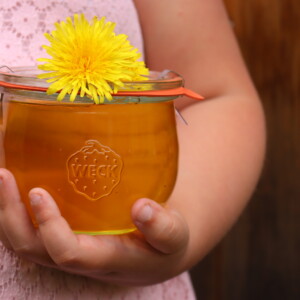
Dandelion Honey
Ingredients
- 2 cups water
- 1 cup dandelion petals, yellow parts only, fluffy, not packed
- 1 cup sugar
- 1/2 Tbsp. lemon juice, or 1/8 tsp. citric acid, not optional
Instructions
- Start by harvesting dandelions from a clean, unsprayed area.
- Break the flowers in half (left to right) to expose their center. Gently pluck out the yellow petals inside, leaving behind the green sepals around the outside. Measure your petals and scale the recipe accordingly. (For a basic recipe, you need about 1 cup of fluffy, unpacked petals from about 1 quart of whole dandelion flower heads.)
- Add two cups of water to a saucepan and bring the water to a boil on the stove. Once boiling, remove it from the heat. Add the cleaned dandelion petals, and allow them to infuse for about 30 minutes (or longer, if you prefer.)
- Strain the dandelion petals, saving the dandelion tea you've just made. (At this point, you should have about 1 1/2 cups of dandelion tea, or a bit more, depending on how efficient you are when you strain it. You lose some to boiling the water, and then the petals absorb some. It doesn't really matter, as you're going to cook it down and drive off more water shortly to get the right thickness or sugar concentration in the finished dandelion honey.)
- Return the liquid to a saucepan on the stove and add sugar and lemon juice.
- Turn the heat to high and boil hard until the mixture thickens and reaches "thread stage" on a candy thermometer, which is 230 F to 235 F (or 110 to 113 C). This should take about 8 to 10 minutes, depending on your stove.
- An instant-read thermometer or candy thermometer is incredibly helpful here, as it's hard to judge the thickness of the mixture when it's hot. The dandelion honey is going to thicken considerably when it cools. (If you don't have a candy thermometer, you can also just eyeball it. In that case, it's better to undercook it than overcook it. Bring it to a hard boil, stir until everything is dissolved, and allow it to cook for just a few minutes. Let it cool completely, and check the consistency. If it's too thin, bring it back to a boil again, then turn off the heat. You can keep doing that repeatedly until it cools to the right consistency. Be aware that it thickens as it cools, so just bring it to a boil and then turn it off each time. If you overcook it, it'll turn to hard candy...if you undercook it, you can just heat it again.)
- Once the dandelion honey reaches the proper temperature, remove it from the heat and pour into jars for storage.
Notes
Shelf Life
Dandelion honey is high in sugar, which is a natural preservative, but it doesn't have all the natural anti-microbial compounds that real honey contains. Real honey is shelf stable indefinitely, but dandelion honey is not. Be sure to use lemon juice or citric acid, which will improve the flavor of your dandelion honey, but is also required for preservation. It's not optional. Properly sealed jars, that are either water bath canned or canned using the European method (described below), will keep on the pantry shelf without refrigeration. Once opened, the dandelion honey should be refrigerated like any jam or preserve. If you only fill up half a jar, or don't seal the jar properly, consider it an "open jar" and refrigerate it for storage. European Canning Method: If you sterilize the jars beforehand in boiling water, and fill the jars to within 1/4 inch of the top, the jars should "seal" on their own simply from the heat. In that case, they're effectively canned using the "European method" for canning, which uses a high sugar preserve and skips the water bath canning process. The same method is used in the US for canning maple syrup commercially. Water Bath Canning: You can also choose to water bath can the dandelion honey, in which case, you'd process the jars for 10 minutes below 6,000 feet in elevation or 15 minutes above 6,000 feet in elevation. If you're not familiar with water bath canning, I'd suggest reading my guide to water bath canning before you start.Traditional Apple Pectin Method
The other method for making dandelion honey which I described in the full article, uses green apples to thicken the "honey" and requires a bit less sugar. It's a little less sweet, and more like a soft set jelly. It won't cook the same as honey in baked goods, but it does work well in tea on and on top of biscuits. For that variation, you'll need:- 3 cups chopped green apples (about 1 pound of whole apples)
- 2 cups dandelion petals, cleaned yellow parts only
- 4 cups water
- 2 Tbsp lemon juice (or a few stalks of chopped rhubarb for acidity)
- Sugar, added later
Dandelion Recipes
Looking for more ways to use dandelions from root to blossom? Try these dandelion recipes:
Edible Flower Recipes
Looking for more ways to use edible flowers?
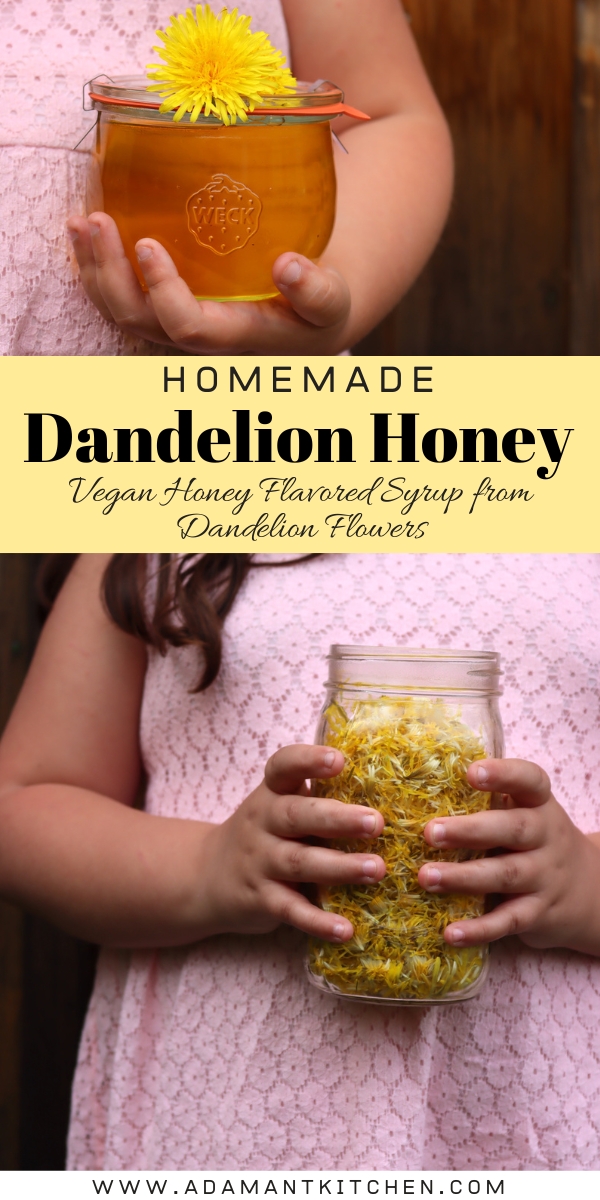
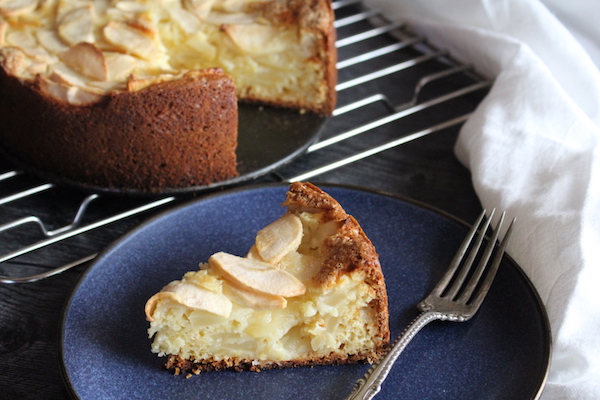
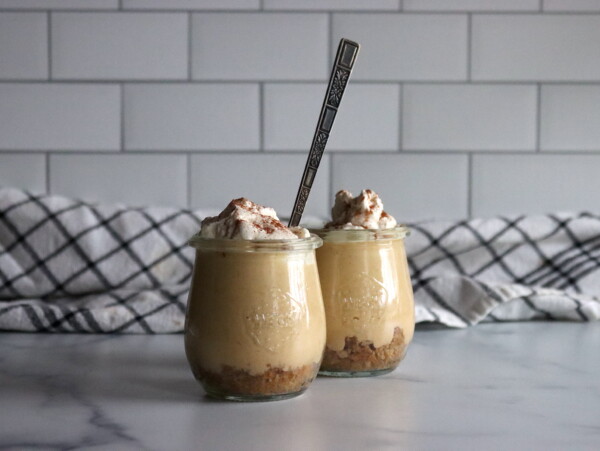
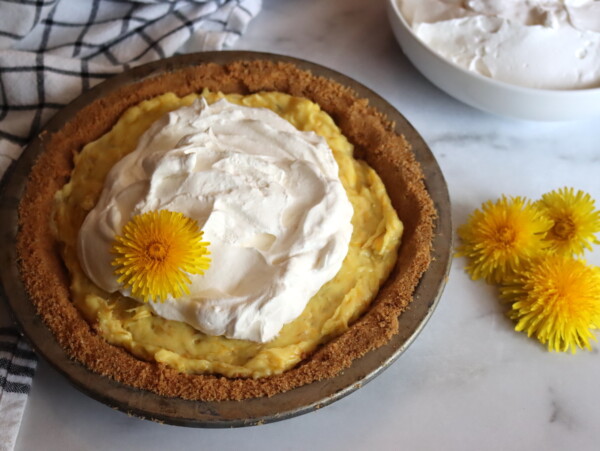
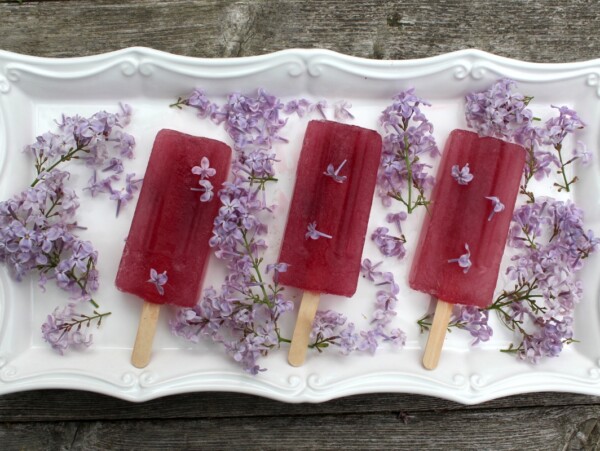
This turned out excellent. Going to make more. I was suprised how clear it came out. It looks just like honey and really close taste also.
Wonderful!
Do you rinse the petals at all to clean them to get any bugs or dirt off?
Yes, you can rinse them. I just tend to harvest them right after they open and check them as I’m harvesting them, so they’re pretty darn clean.
Hello,
I only have a lime, would that work?
Yes, that will work, as it adds the same acidity, but the flavor will be different.
I think I burnt mine 🤦
It’s tricky, and I’ve had that happen. As it gets close to finished it is much more likely to scorch. It may still be quite good, if it’s not crazy burnt, just a little overcooked will give you kind of like a dark honey/caramel taste which is lovely too. Really burnt though, that’s not tasty sadly.